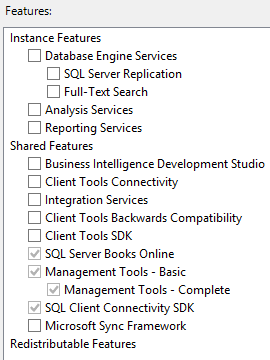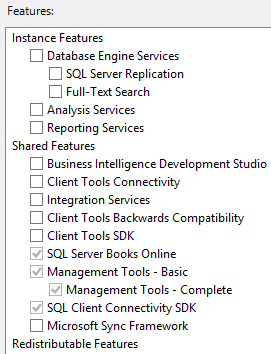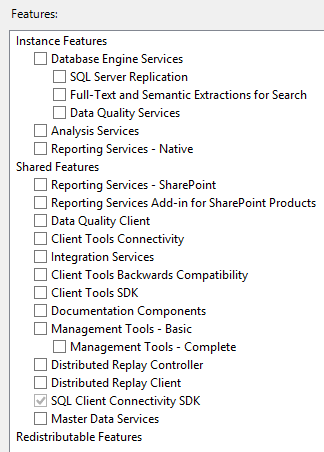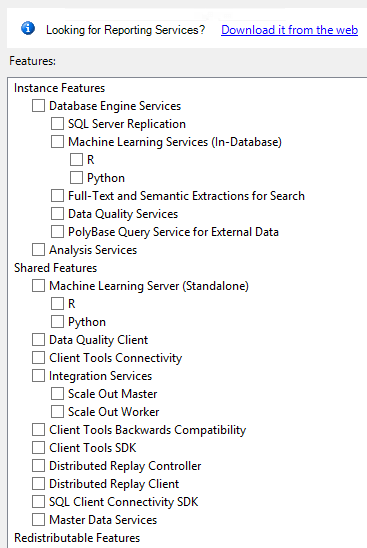If you happen to install several SQL Servers in a row, you’ll notice differences from over the years in the feature list.
SQL Server 2008
Ah, a simpler time. When you got to the feature selection screen, here were your choices:

In case you’ve forgotten, Business Intelligence Development Studio (BIDS) was like SSMS for BI people, and the Microsoft Sync Framework was for rolling your own replication to stuff like handhelds.
SQL Server 2008R2
SQL Server has always had a next-next-next reputation: people threw in the install media, clicked next-next-next, and went live. That approach to installation has always led to great consulting business, but in 2008R2 Microsoft took it to the next level. If you couldn’t be bothered picking features individually, you had a new radio button: “All Features With Defaults.”

Hoo boy. That was a great time for consulting. Also, I’ll call your attention to “SQL Server PowerPivot for SharePoint,” rarely referred to by its acronym, SSPSP.
Assuming you weren’t on cocaine, you chose “SQL Server Feature Installation” instead of “All Features With Defaults,” so then you got the normal list of checkboxes. No changes here from SQL Server 2008, same short list:

No changes here for 2008R2. Moving on.
SQL Server 2012: Featurepalooza
After the PowerPivot and “All Features With Defaults” screen, the feature list came up:

More features! Some of the “highlights” of the new stuff included:
- Data Quality Services
- Reporting Services was split into Native and SharePoint
- Documentation Components (formerly known as Books Online)
- Distributed Replay
- Master Data Services
Removed: Business Intelligence Developer Studio (BIDS)Removed: Microsoft Sync Framework
Around this time, when I was talking to DBAs, I talked a lot about the danger of adopting new features. Just because something new is thrown into the box doesn’t mean it’s going to get any kind of adoption, nor any kind of further development from Microsoft. Ask folks who worked with BIDS, DQS, MDS, and Distributed Replay about how that went. (I’ll come back to that, though.)
SQL Server 2014
The PowerPivot and “All Features With Defaults” was still here, and after that, the feature list was the same as 2012:

No changes. You can kinda think of 2014 as SQL Server 2012 R2.
SQL Server 2016: R, matey
The “All Features With Defaults” and PowerPivot options were removed. Yay! After that, the feature list:

Changes:
- R Services (In-Database)
- R Server (Standalone)
- PolyBase Query Service for External Data
Removed: Client Tools SDKRemoved: Management Tools (SSMS, now a separate download)
SQL Server 2017
I’m taking a screenshot here of the Windows installer, but of course it was also huge news that setup worked on Linux and in containers. The feature list:

Ch-ch-ch-changes:
- Removed: Reporting Services (now a separate download)
- Python In-Database
- Python (Standalone)
- Integration Services Scale Out Master, Worker
It’s interesting because it seems like there’s two warring camps at Microsoft: one camp who wants to put everything in the SQL Server installer, and another camp who wants separate installers for different services. I’m not sure the “Machine Learning Server (Standalone)” makes more sense to have in this installer – after all, the word “(Standalone)” usually kinda means, uh…well, you get the point.
Remember how I said I used to advise people to think long and hard before using new features? I’m not as concerned about that these days because Microsoft seems to also be deploying variants as cloud services. For example, R, Python, and Integration Services have bright futures in the cloud and on other platforms (like Azure Data Factory.)
One other funny note: all of these installers are currently supported to varying degrees. Microsoft has its hands full – think about the number of people they need to know all these changing features.


4 Comments. Leave new
I find it interesting to note that “SQL Server Books Online” quietly evaporated between 2008R2 and 2012. I think that went hand in hand with the disappearance of the encyclopedia set sized stack of books that came with earlier versions of SQL server. Sometimes, I miss those books. They worked great as monitor stands.
At my last position, I took over an environment where the previous “DBA” had been someone who had just been handed the job because they needed someone to do it. All the servers (at the time mostly 2008 R2) had all of the options installed (and 90% of the servers had Enterprise Edition installed whether it was warranted or not), so every server had SSRS, SSAS, BIDS, and Replication needlessly installed. I spent an afternoon just going from server to server and turning off unneeded services.
When I think sql served, I always think cocaine. What?
BIDS didn’t went away, it was just renamed to SSDT (actually first SSDT-BI, then SSDT). It has gotten quite some love from MS and SSDT has a lot of adoptation. In fact, my most popular blog post nowadays is about SSDT for SQL Server 2017.
MDS has also gotten quite some love in SQL Server 2016: lots of new features and a new UI.
DQS … ehrm …. Okay it’s as dead as can be 🙂